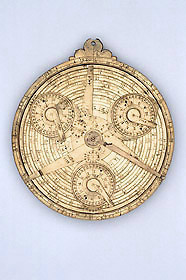 |
| Menu |
 |
| |
| |
 |
| Catalogue |
 |

Equatorium
Unsigned
Late 15th century; French
Brass; 193 mm in diameter
An equatorium is one of the more rare among early astronomical instruments. It is used to calculate the past or future positions of the planets according to the planetary theory of Ptolemy. In this case the instrument has three prominent small circles or 'epicycles', which can be adjusted to serve for planetary positions in three groups: the moon, the 'inferior' planets of Mercury and Venus, and the 'superior' planets of Mars, Saturn and Jupiter. The sun was considered a planet in the Ptolemaic system, but it, along with the stars, is treated by the astrolabe on the other side of the instrument. Positions of all the elements in the astronomy of Ptolemy can thus be found with a single instrument. In fact the indications are that this instrument was used for the astrological aspects of medicine, as the unusual provision of two retes and especially the medical lines on one of the astrolabe plates, give it this specialist function.
Museum of the History of Science, Oxford
Inventory number 49847
© Museum of the History of Science, Oxford. All rights reserved. Information and images provided here may not be reproduced in any form or by any means without the prior written permission of the museum.
Basic URL: http://www.mhs.ox.ac.uk/epact/catalogue.php?ENumber=34746 |
|


